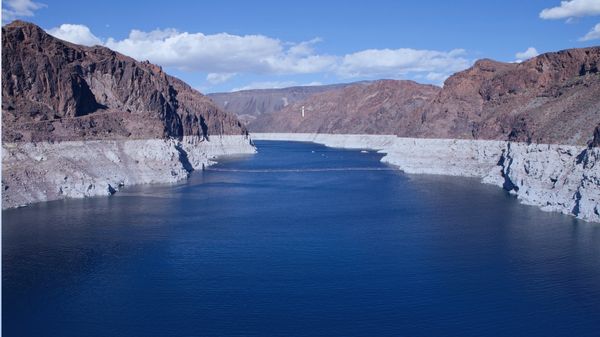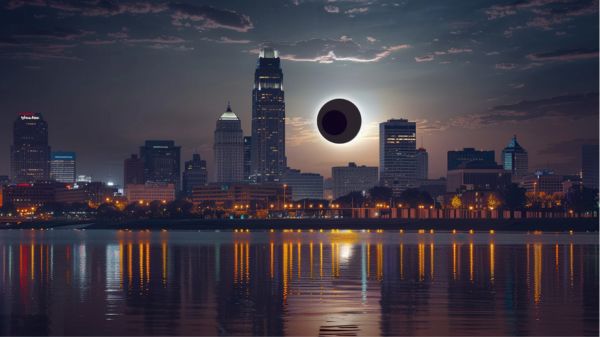You’re facing a stark reality on rapid water level decrease in Lake Mead to those not seen since the 1930s, now under 40% capacity. This alarming trend is fueled by prolonged droughts, inefficient water use, and overallocation. Impacts are profound; hydroelectric power from Hoover Dam is dwindling, local wildlife and plants are struggling, and ghost towns are re-emerging, drawing tourists.
Furthermore, lower water levels concentrate pollutants, escalating the risk of harmful algae blooms. Climate change predicts worsening conditions, with urgent action required to mitigate impacts. Understanding these dynamics offers insights into future challenges and necessary adaptive strategies.
Beat the Drought: DIY Water Generation with Air Fountain

Key Takeaways
- Lake Mead’s capacity has plummeted to below 40%, reaching historic lows not seen since the 1930s.
- Projected further drops of 60-100 feet over the next 50 years could threaten essential water supplies.
- Receding waters are exposing submerged ghost towns, turning them into tourist attractions and boosting local economies.
- The decline in water levels is severely impacting hydroelectric power output from Hoover Dam, challenging energy sustainability.
- Exacerbated by climate change, worsening conditions include increased evaporation and altered precipitation patterns, escalating the crisis.
Historical Low Water Marks
Lake Mead’s water levels have hit historic lows, with current measurements revealing depths unseen since its creation in the 1930s. This situation isn’t unlike the global energy crisis, where we’re witnessing a similar management crisis but in the domain of renewable resources.
You’re observing a water management crisis that could script a Monty Python skit, but with less laughter and more furrowed brows. Historically, Lake Mead has been the heavyweight champion of water reservoirs in the U.S., thanks to the Hoover Dam‘s mammoth efforts. But now, it’s more like a lightweight, struggling in the ring of drought and consumption.
Here’s a splash of cold water for you: the lake’s current state isn’t just a curious tidbit for your next trivia night; it’s a critical marker of water management woes. The lake’s capacity has dipped below 40%, a level that sets off alarms louder than your morning coffee maker.
This isn’t just historical significance for the books; it’s a live-action drama about resource management playing out on a vast, aquatic stage. As you dive deeper into the data, it’s evident that the repercussions are vast. Each inch of water lost means less power generation, fewer water supplies for millions, and a drier future.
Revealed Ghost Towns
As water levels in Lake Mead continue to plummet, a series of ghost towns, once submerged, are now re-emerging along the lake’s receding shores. You’re witnessing not just a drop in water, but a rise in historical relics, perfect for ghost town tourism. Imagine the selfie opportunities!
Dive into the analytics: each town reveals unique architectural remnants and artifacts, painting a vivid picture of life before Lake Mead even existed. Historians and tourists alike are flocking to these spots, equipped with cameras and a keen eye for the past. It’s like a treasure hunt, except the treasures don’t sparkle—they narrate stories.
Now, let’s get technical. The rate of re-emergence correlates directly with the water’s decline, at about 0.13% per month. This slow exposure allows for gradual, detailed studies, ensuring that historical preservation is thorough, though you gotta feel for the historians, documenting ruins under the blazing sun.
The uncovering of these towns isn’t just a boon for history buffs but also stimulates local economies. Every ghost town that surfaces is another hotspot on the tourist map, blending eerie aesthetics with educational value. Who knew a receding lake could reveal so much, right?
Impact on Hydroelectric Power
Significant declines in Lake Mead‘s water levels aren’t only revealing hidden ghost towns but also fundamentally impacting hydroelectric power production at Hoover Dam. These water levels are essential for generating this renewable energy source, which is constantly replenished by the natural water cycle.
As the water turns tail and runs, so does the dam’s ability to pump out the watts we need. Lower water levels mean less pressure to spin those massive turbines, leading to a drop in hydroelectric efficiency that’s as noticeable as a toupee in a hurricane.
Here’s the deal: Hoover Dam’s capacity is directly tied to the head — that’s the height difference between the water upstream and downstream. Typically, this towering aquatic advantage lets us churn out over 4 billion kilowatt-hours per year — enough to keep the lights on in every Las Vegas casino without breaking a sweat.
But now, with Lake Mead looking more like Lake Mini, we’re losing that precious pressure, and with it, the power output. This isn’t just about fewer neon lights in Sin City; it’s a serious hiccup in our energy sustainability goals. Hydroelectric power, being a clean and sustainable energy alternative, plays a significant role in reducing our dependence on non-renewable sources like coal and oil.
If you’re betting on green energy, hydroelectric power is usually a safe bet — but only if there’s enough water to back it up. So, let’s not water down the importance of managing our resources, or we might just end up high and dry, literally.
Threats to Wildlife Habitats
While the dwindling water levels at Lake Mead strip Hoover Dam of its hydroelectric prowess, they also wreak havoc on local wildlife habitats. You’ve got critters out there playing musical chairs with disappearing habitats, and let me tell you, it’s not a pretty sight. As water retracts, it’s like someone yelled, “Scatter!” at a squirrel party—wildlife migration kicks into high gear, but the options are looking bleak.
Habitat fragmentation isn’t just a fancy term your local ecologist throws around to sound smart at parties. It’s a real issue here. Imagine you’re a bird that used to vacation at Lake Mead (because who wouldn’t?), and now you find the lake’s turned into a puddle. Your once-luxurious waterpark is now a mud wrestling match. This forces species to either adapt quickly or mail in their retirement cards early.
As these habitats shrink and split into isolated patches, animals face tougher commutes for food, water, and Tinder dates. Yes, even animals have dating pools, and let’s just say, the pool’s running dry.
Shrinking Recreational Areas
The dramatic plunge in Lake Mead’s water levels not only affects local wildlife but also considerably reduces the area available for recreational activities. You might’ve noticed your favorite picnic spots and boat ramps now resemble scenes from a dystopian road trip rather than the lush lakeside vistas you’re used to.
As the water recedes, here’s what you’re up against:
- Shrinking Beachfronts: Not only are your sunbathing options dwindling, but the trek to reach the water’s edge now feels like a mini-hike. Hope you’ve packed good sneakers!
- Compromised Boat Launches: Launching your boat now requires a GPS and possibly a sherpa. Reduced water levels mean fewer operational ramps, and those still in use are busier than a discount aisle on Black Friday.
- Altered Water Sports Terrain: Water skiing over tree stumps? It’s not an extreme sport; it’s just what happens when water levels drop and previously submerged hazards make a grand appearance.
These changes aren’t just a bummer for your weekend plans—they also raise serious concerns about recreational safety and visitor experience. Staying informed and adaptable is your best bet to still have fun and keep safe. So, keep an eye on updates and maybe consider desert hiking as your next hobby?
Alarming Rate of Decline
You’ve seen the stark visuals of Lake Mead’s receding waters, but the causes, ecological impacts, and future water predictions underscore a more dire situation. Lake Mead’s water levels have plummeted at an unprecedented rate, primarily due to prolonged droughts and overallocation, which not only disrupt local ecosystems but also threaten water supplies for millions. As we assess these trends, it’s essential to understand how further declines could alter the landscape and water management policies.
Causes of Water Loss
Several factors contribute to Lake Mead’s alarming water level decline, each compounding the urgency of the situation. You’re in for a splash of harsh reality mixed with a sprinkle of dry stats, so buckle up!
- Drought Conditions: It’s no secret that Mother Nature’s been a bit stingy with the rain. The relentless droughts have turned what was once a bustling lake into a sad, giant puddle. The numbers don’t lie; precipitation levels are hitting record lows, and it’s not just because the weather gods are upset.
- Water Management: Whoever’s in charge of doling out the water needs a calculator refresh. There’s a fine art to balancing water supply and demand, and let’s just say it’s been more Picasso than precise. Overallocation and inefficient usage have drained Lake Mead faster than a bathtub with a toddler in control of the plug.
- Increased Consumption: As if we needed more straws in the drink, the booming population and expanding agriculture are sucking Lake Mead dry. Picture a never-ending water party where everyone’s invited but no one brought any water.
Ecological Impacts
As we examine Lake Mead‘s ecological impacts, it becomes clear that its rapid decline is wreaking havoc on local ecosystems. You’d think the fish would start a protest about their shrinking habitat, but no, they’re just swimming deeper!
Seriously though, the plummeting water levels are causing water temperatures to rise, and it’s not just making the lake a giant fish sauna. Warmer waters can lead to decreased oxygen levels, which is bad news for aquatic biodiversity. Fish populations are becoming more stressed than a commuter in rush hour traffic.
And it doesn’t stop with the fish. The entire food web is getting a shake-up. Imagine showing up at your favorite restaurant only to find they’ve swapped the menu for something less palatable.
That’s the situation for the species relying on specific aquatic plants and smaller critters that are dwindling as water conditions change. These shifts could lead to significant reductions in species diversity, turning Lake Mead into a less vibrant, more monotonous ecosystem.
It’s like watching a blockbuster movie turn into a low-budget indie film—charming but not what you signed up for. So, let’s not take our eyes off this ecological drama unfolding at Lake Mead.
Future Water Predictions
Predictions paint a grim picture for Lake Mead’s water levels, forecasting a continued and accelerated decline over the coming decades. You might want to hold off on that waterfront property investment unless you’re into desert landscapes! Here’s the scoop summarized:
- Dwindling Down Fast: Over the next 50 years, Lake Mead’s levels could drop by an additional 60-100 feet. That’s like stacking about 10 giraffes on top of each other, and then poof, they’re gone!
- Thirsty Megacities: Cities like Las Vegas are slurping up the lake quicker than a kid with a milkshake. Despite their efforts at water conservation, the demand continues to outpace the supply.
- Agricultural Adjustments: Farmers are getting savvy with sustainable practices, but it’s like switching from a firehose to a garden hose during a house fire—helpful, but maybe not enough.
You’re probably thinking, “So, what can we do?” Well, the ball’s in our court! Embracing water conservation methods and integrating more sustainable practices in our daily lives aren’t just good ideas; they’re necessities. Think of it as helping your future self avoid turning into a cactus. So, let’s get to saving every drop, shall we?
Economic Ramifications
How will the plummeting water levels at Lake Mead affect local economies? Well, strap in because it’s not just the water going down the drain, but possibly a chunk of the economy too.
First off, the shrinking water supply isn’t just a bummer for your pool party plans; it’s a massive headache for agricultural sectors that depend heavily on this water. We’re talking reduced crop yields, skyrocketing irrigation costs, and yes, potentially more expensive avocados. You might want to rethink that guacamole habit!
As water levels hit record lows, the ripple effects are drenching more than just the fields. Local businesses reliant on agricultural outputs are seeing their input costs climb, squeezing profit margins tighter than a pair of jeans post-Thanksgiving dinner.
And let’s not forget the tourism sector. Fewer water sports and scenic water views could turn Lake Mead from a bustling tourist hotspot into a ghost town. This isn’t just about fewer selfies by the lake; it’s about significant dips in local spending, job cuts, and an economy gasping for liquidity as much as the lake needs water.
Emerging Water Quality Issues
As Lake Mead’s water levels continue to drop, you’ll notice a concerning increase in the concentration of pollutants. These contaminants, once diluted, are now more potent and pose significant risks to water safety and ecology. Additionally, the warmer, shallower waters are ideal for algae blooms, which could further degrade water quality and affect local wildlife.
Contaminant Concentration Increases
With Lake Mead’s water levels dropping, contaminants previously dispersed throughout a larger volume of water are now more concentrated, posing new risks to both ecosystem health and public safety. You’re not just imagining things; your glass of water might just have more than just H2O and love from Lake Mead!
Here’s a quick peek at what’s brewing in the lake:
- Increased Heavy Metal Presence: As water levels shrink, heavy metals like mercury, which were once safely buried in sediments, are making a grand re-entrance into the water column. Cheers to an unexpected chemistry lesson in your water glass!
- Pesticide Party: With less water to dilute them, concentrations of agricultural runoff and old pesticide deposits are climbing. It’s like they’re all coming back for a reunion, and frankly, they’re not the guests you want sticking around.
- Industrial Chemicals Galore: Industrial runoff isn’t being shy either. These contaminants are becoming more prominent, giving a whole new meaning to having a ‘strong’ drink of water.
To manage these uninvited guests, understanding the contaminant sources is key. It’s not just about spotting them at the party; it’s about keeping them out. Enhanced water filtration systems are now more essential than ever. They’re not just accessories; they’re necessities, ensuring that your tap water doesn’t turn into a chemical cocktail. Drink up but let’s filter first, shall we?
Algae Bloom Risks
You’re now facing a new challenge in Lake Mead: the rapid increase in algae blooms. As if watching your favorite lake shrink wasn’t entertaining enough, now you’ve got to deal with these green, slimy party crashers. But it’s not just an eyesore; it’s a serious water quality issue, thanks to algae toxicity.
Let’s explore the nitty-gritty. These blooms are fueled by nutrient runoff, primarily phosphorus and nitrogen, which are like energy drinks for algae. They thrive on this stuff! As water levels drop, the concentration of these nutrients increases, turning Lake Mead into an all-you-can-eat buffet for algae.
But here’s the kicker: when algae die, they decompose, which sucks oxygen out of the water faster than a shopaholic with a credit card at a clearance sale. This process can create dead zones, areas in the lake where life is as scarce as a truthful politician.
Plus, some algae can produce toxins harmful to fish, wildlife, and even humans. So next time you plan a lake day, you might want to check the water quality reports unless you fancy a swim with a side of toxins. Keep your eyes peeled; it’s getting wild out there!
Climate Change Connections
Despite its serene appearance, Lake Mead’s plummeting water levels are a stark indicator of climate change’s pervasive impact. You know things are getting real when even the fish start to sweat—or at least they’d if they could!
But let’s explore the not-so-funny parts:
- Increased temperatures: Warmer weather isn’t just great for your pool parties; it also increases evaporation rates. Lake Mead is literally getting air-dried like your favorite beef jerky. This rapid evaporation is similar to the effects of not covering outdoor swimming pools, a common conservation tips which could reduce evaporation by up to 50%.
- Reduced snowpack: The mountains are skimping out on snow, which means less runoff to feed the lake. It’s like expecting a river from a dripping tap. This issue highlights the importance of turning off faucets when not in use, a simple everyday water-saving habit that could save significant amounts of water.
- Overallocation: Everyone wants a piece of the pie, but unfortunately, it’s a shrinking pie. Water management is turning into a game of musical chairs.
These factors aren’t just bad news for water skiers and fish; they’re a wake-up call for urgent action in water conservation and climate policy. Think of it as a diet plan for water usage; less is more sustainable. By addressing these issues, you’re not only saving water but also helping to stabilize the climate, which may just keep Lake Mead from turning into a desert mirage.
Future Projections and Concerns
Looking at what lies ahead, the situation at Lake Mead paints a concerning picture for the coming decades. If you’re thinking of water-skiing on a puddle, that’s where we might be heading without some serious changes. Let’s explore the data.
Projections show that if current trends continue, Lake Mead’s water level could drop considerably, risking a “dead pool” status where water can’t flow downstream. Imagine trying to get the last bit of a milkshake through a straw—frustrating, right? That’s Lake Mead’s future without intervention.
Now, let’s talk water conservation. It’s no longer just about shorter showers and not watering your lawn during a heatwave. It’s about overhauling how communities use water—big time. Cities around Lake Mead could see water restrictions that make current measures look like child’s play.
And for the policy wonks, the implications are as deep as the lake used to be. Governments might need to rewrite the rulebook on water rights, pushing for innovative policies that prioritize sustainability over short-term gains. Think less “water fight with your neighbor” and more “group project on saving the planet.”
Frequently Asked Questions
How Does Lake Mead’s Water Level Compare to Other U.S. Lakes?
Compared to other U.S. lakes, Lake Mead‘s water level is dropping faster than a dropped call in a tunnel. While some lakes fluctuate mildly, Mead’s dramatic plunge stands out. This isn’t just a local Vegas show; it’s a regional headliner with impacts spreading faster than a meme. Analyzing lake comparisons reveals this isn’t just a puddle problem—it’s an urgent wake-up splash calling for water management strategies that stick better than a wet T-shirt.
Are There Any New Species Discovered in Lake Mead Recently?
You might be surprised, but no new aquatic species have been discovered in Lake Mead recently. Despite the dramatic scenes you’re imagining, the biodiversity impact remains steady, with the usual suspects swimming around. So, if you’re fishing for exciting new creatures, you’ll need to cast your net elsewhere. Keep those binoculars handy, though; nature always has a few tricks up her sleeve, just not in Lake Mead’s current storyline!
What Role Do Local Industries Play in Lake Mead’s Water Depletion?
Did you know local industries slurp up millions of gallons from Lake Mead annually? That’s right, industrial consumption is a thirsty business, heavily impacting the lake’s levels.
Especially, the agricultural sector plays a big part, as it guzzles a significant portion of this water. Analyzing water usage data reveals that these industries aren’t just sipping; they’re fundamentally putting a straw into the lake and taking deep gulps, contributing massively to its depletion.
Is There a Specific Event That Drastically Reduced Lake Mead’s Water Levels?
No single event can be pinned for Lake Mead’s drastic water level drop, but ongoing droughts, exacerbated by climate change, play a major role. These aren’t your weekend garden-variety dry spells; we’re talking about a long-term thirst that’s sucking Lake Mead dry. Imagine climate change as a straw and Lake Mead as your soda; that long sip isn’t stopping anytime soon.
How Do Lake Mead’s Water Issues Affect Surrounding State Policies?
As Lake Mead’s levels plummet, it’s not just a drop in the bucket; it’s a tidal wave of change for surrounding states. You’ll see water management strategies overhauled, with policy implications rippling out like waves. States are neck-deep in data, analyzing trends to craft rules that keep taps running without draining resources dry. It’s a high-stakes balancing act, with humor as dry as the lakebed, ensuring everyone’s glass remains half full, not empty.
Conclusion
Well, you’ve seen it. Lake Mead’s turning into a puddle, ghost towns are popping up like it’s Halloween, and the fish might soon need snorkels! Who knew? As the water dips lower, power outputs and economies are doing a fantastic belly flop. Prepare those water filters, folks, because quality’s taking a nosedive. And let’s not forget, climate change is just adding spice to the mix. So buckle up, Lake Mead’s future projections are less a forecast and more a wild, dry ride.




